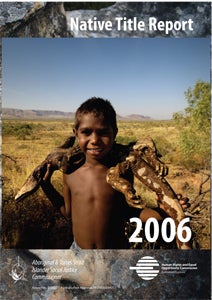Native Title Report 2006: Acknowledgements and Note
Archived
You are in an archived section of the website. This information may not be current.
This page was first created in December, 2012
Native Title Report 2006
Acknowledgements and Note
- Acknowledgments
- Note - Use of the terms ‘Aboriginal and Torres Strait Islander peoples’ and ‘Indigenous peoples’
Acknowledgments
The Aboriginal and Torres Strait Islander Social Justice Commissioner acknowledges the work of Human Rights and Equal Opportunity Commission staff (Fabienne Balsamo, Katie Kiss, Hamish McLeod, Jemma Hollands, Dianne Biaggini, Anna Dawson, Christina Kenny, Julia Mansour, Kirsty Champion and Darren Dick).
Artist Acknowledgement

The cover photograph is courtesy of the Argyle Diamond Mine. Michael Ramsay Jnr, son of Lena Carey and Michael Ramsay, lives in Bow River. He is cared for by his paternal grandmother Mona Ramsay, a Traditional Owner of the land occupied by the Argyle Diamond Mine.
About the Social Justice Commission logo

The right section of the design is a contemporary view of traditional Dari
or head-dress, a symbol of the Torres Strait Island people and culture. The
head-dress suggests the visionary aspect of the Aboriginal and Torres
Strait Islander Social Justice Commission. The dots placed in the Dari
represent a brighter outlook for the future provided by the Commission’s
visions, black representing people, green representing islands and blue
representing the seas surrounding the islands. The Goanna is a general
symbol of the Aboriginal people.
The combination of these two symbols represents the coming together
of two distinct cultures through the Aboriginal and Torres Strait Islander
Commission and the support, strength and unity which it can provide
through the pursuit of Social Justice and Human Rights. It also represents
an outlook for the future of Aboriginal and Torres Strait Islander Social
Justice expressing the hope and expectation that one day we will be
treated with full respect and understanding.
© Leigh Harris
Note - Use of the terms ‘Aboriginal and Torres Strait Islander peoples’ and ‘Indigenous peoples’
The Aboriginal and Torres Strait Islander Social Justice Commissioner recognises
the diversity of the cultures, languages, kinship structures and ways of life of
Aboriginal and Torres Strait Islander peoples. There is not one cultural model that
fits all Aboriginal and Torres Strait Islander peoples.
Aboriginal and Torres Strait Islander peoples retain distinct cultural identities
whether they live in urban, regional or remote areas of Australia.
Throughout this report, Aborigines and Torres Strait Islanders are referred to
as ‘peoples’. This recognises that Aborigines and Torres Strait Islanders have a
collective, rather than purely individual, dimension to their livelihoods.
Throughout this report, Aboriginal and Torres Strait Islander peoples are also
referred to as ‘Indigenous peoples’.
The use of the term ‘Indigenous’ has evolved through international law. It
acknowledges a particular relationship of Aboriginal people to the territory from
which they originate. The United Nations High Commissioner for Human Rights
has explained the basis for recognising this relationship as follows:
Indigenous or aboriginal peoples are so-called because they were living on their
lands before settlers came from elsewhere; they are the descendants - according
to one definition - of those who inhabited a country or a geographical region
at the time when people of different cultures or ethnic origins arrived, the new
arrivals later becoming dominant through conquest, occupation, settlement or
other means… (I)ndigenous peoples have retained social, cultural, economic and
political characteristics which are clearly distinct from those of the other segments
of the national populations.Throughout human history, whenever dominant neighbouring peoples have
expanded their territories or settlers from far away have acquired new lands by
force, the cultures and livelihoods - even the existence - of indigenous peoples
have been endangered. The threats to indigenous peoples’ cultures and lands, to
their status and other legal rights as distinct groups and as citizens, do not always
take the same forms as in previous times. Although some groups have been
relatively successful, in most part of the world indigenous peoples are actively
seeking recognition of their identities and ways of life.1
The Social Justice Commissioner acknowledges that there are differing usages of
the terms ‘Aboriginal and Torres Strait Islander’, ‘Aboriginal’ and ‘indigenous’ within
government policies and documents. When referring to a government document
or policy, we have maintained the government’s language to ensure consistency.
[1] United Nations High Commissioner for Human Rights, Fact sheet No.9 (Rev.1), The Rights
of Indigenous Peoples, www.unhchr.ch/html/menu6/2/fs9.htm
